Table of Contents
The Weeping willow is one of the most cultivated species of a Bonsai tree. Over the years, the Weeping willow has become the favorite of many indoor plant lovers and gardeners because of its droopy leaves, branches, and flowers. Plus, it is a fast-growing plant.
However, the artistic impression of a Weeping willow is not an easy feat to achieve as they require a lot of water and their natural strong growth must also be under close monitoring.
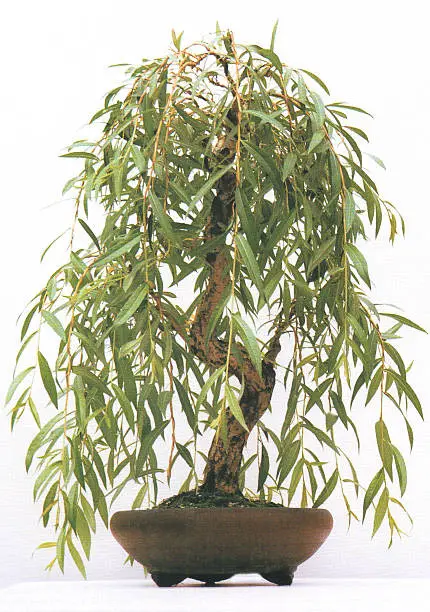
In this article, I will be sharing facts as well as proper care tips on how to cultivate a Weeping willow Bonsai.
| Scientific name | Salix babylonica |
| Age of the plant | 40 and 75 years |
| Height of the plant | 30.00 to 50.00 feet |
| Width of the plant | 30.00 to 50.00 feet |
| Family | Salicaceae |
| Popular in | Northern China |
| Bloom Time | April to May |
| Sunlight requirements | Full sun |
| Water | Moderate (some season need wet) |
| Maintenance | Medium |
| Common problems | Powdery mildew |
| Repotting of plant | Every 2 years |
Weeping willow Bonsai history
The history of Weeping willow is traced back to two origins – Asia (China and the Korean peninsula) and the early European settlers. Although in the history of Weeping willow Bonsai tree that was traced back to Asia it was difficult to pinpoint the exact country of origin.
According to the Asian origin, it was believed that Weeping willow Bonsai was grown at large in China during the era of the Song dynasty between 960 to 1279. Although in some other historical narrations, it was believed to have been in cultivation since the 10th century. Also, according to this source, some 1000 years ago, the first documentation of Bonsai trees started in a place (unknown) around the Korean Peninsula.
According to another source, it was narrated that the Weeping willow was first discovered by the early European settlers who cultivated them extensively mainly because of their aesthetic appeal and their therapeutic purpose. They use Weeping willow Bonsai trees to treat Insomnia, skin conditions, and reproductive issues.
Is Weeping willow a good option for Bonsai?
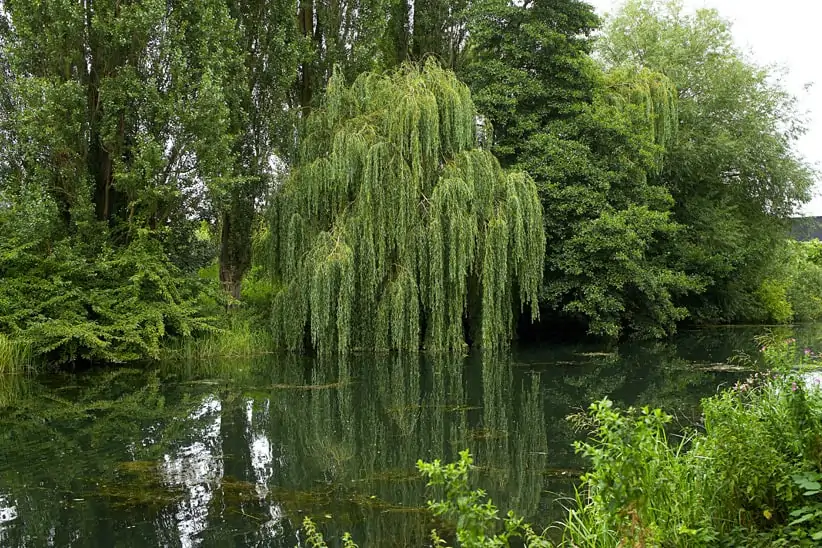
Yes, Weeping willow is a good option for Bonsai. Weeping willow Bonsai are known for their saggy leaves and branches which most growers find appealing for decorative purposes.
However, before picking Weeping willow as your top choice, you must know that raising this deciduous tree is not an easy task and that is why most people prefer Weeping tree as an outdoor plant so they wouldn’t have to create spaces for the drooping leaves and branches.
This article is meant to make the whole process simple, so if you know you are up to the task, read on to the very last page.
Weeping willow Bonsai scientific name
The scientific name of a Weeping Willow Bonsai tree is Salix babylonica. Other names of Weeping willow include Babylon willow and Shidare Yanagi.
Weeping willow Bonsai care
I said earlier that raising a Weeping willow Bonsai is not easy as certain extra efforts need to be put into growing a healthy, aesthetically beautiful Bonsai tree. In this section, I will be discussing extensively, all requirements necessary for the successful cultivation of a weeping willow Bonsai tree.
Weeping willow Bonsai temperature
The prevailing temperature under which a weeping willow is planted is very essential to their growth. A typical Weeping willow loves a relatively warm environment. It will do well under any temperature ranging from 75°F to 95°F (23-25 degrees celsius). If this is the prevailing level of temperature in your area all through summer and spring, then you can safely grow your Bonsai outdoors.
Although, this is only just an ideal level of temperature for a Weeping willow as they can survive well outside the range of temperature provided herein as much as the temperature isn’t too much or you put your Bonsai under such condition for an extended period.
During winter, you should prevent your Weeping willow from direct exposure to freezing temperature as they can negatively affect the root system. However, you should also know that keeping them inside for indoor warmth will also require you to water them more, so you might have to make necessary adjustments to your watering schedule, to keep the soil moist.
Weeping willow fertilizer
Weeping willows grow well when treated with either traditional or foliar fertilizers (spraying the branches and foliages with liquid fertilizers).
However, you should note that the best fertilizer for a Weeping willow Bonsai soil is fertilizers that are water-soluble, rich in potash (potassium), phosphoric acid, and low in Nitrogen. Check the packaging of the organic fertilizers you intend to use for information about the content level of each mentioned here.
You can also make use of fertilizers that contains an equal amount of these nutrients (potash, phosphoric acid, and Nitrogen). Fertilizers like this are commonly called 20/20/20 mixtures.
Fertilizers should be applied to a Weeping willow Bonsai tree once a month and must be given at half its strength and this should be done during summer and spring.
Weeping willow Bonsai Pruning and Trimming
The weeping willow is a fast-growing tree, and as a result, must be pruned regularly to stay healthy and also to be able to shape the tree into your desired style. To avoid having compacted branches and leaves (a characteristic common to this Bonsai species), you must trim your Weeping willow before the growing season (springtime).
Trimming your Weeping willow at a time like this will allow the tree to grow back its lost leaves and branches, and therefore, you can safely remove up to 2/3 of its leaves without harming your tree. And also, it will create room for you to be able to shape your tree.
If you are pruning during springtime, you will have to frequently pinch or clip off every new sprout on the branches to prevent them from overgrowing. In other seasons, your focus should be on pruning older branches as it is recommended that you leave new shoots to grow so that your action will not affect the growth of the tree in later years.
Note that the schedule discussed is strictly for maintenance purposes, you can make other schedules based on the Bonsai style you aim to achieve. For instance, if you want the natural droopy style of a Weeping willow, you should always trim the branches until you reach the trunk during winter; they will grow back during the next growing season.
How to wire a Weeping willow Bonsai
To shape your Weeping willow into your desired style, you might have to wire it. When wiring a weeping willow, you should know that the bark of a Weeping willow is not as hardy as other types of Bonsai tree, consequently, you must be careful not to wire the branches too tightly. Also, unlike other Bonsai trees that you will wire and abandon, after wiring a Weeping willow Bonsai, you must check it frequently so that you can make necessary adjustments to fit your style.
The best wire to use for a Weeping willow is looser wiring to prevent scarring because the bark of a Weeping Willow is so delicate. The wiring of a weeping willow should be done in such a way that it will be so loose that it can never cause scarring, but must be tight enough to shape the tree to your desired direction.
How to Wire a Weeping willow Bonsai
Follow the steps below to guide you through the different processes involved in wiring a Weeping willow Bonsai. You can use a similar method to wire any kind of Bonsai to look like a weeping willow tree.
- Trim the tree to get rid of all leave and branch excess.
- Wire the branches into your desired direction with a wire cutter or a bent nose plier.
- Get an 18 gauge copper wire and use it to wrap the branches around your fingers.
- Use an elastic band to properly tight the branch; then tie the end of the branch to its trunk.
- Processes should be repeated on all branches.
- Gently pull the wire to check if it is tight (moderately tight in the case of a Weeping willow).
- Cut a strip of clothing and tie it around the place so that the shape can be firm.
- Add soil and moisten it up with water, then leave the tree to grow new roots.
Weeping willow Bonsai repotting
Young Weeping willow Bonsai exhibits rapid growth, and that is why you must take their repotting seriously. The initial pot must be big enough that the root can only use half of the total pot space. You should repot once your tree root system starts to grow past this space.
When to repot Weeping willow Bonsai
Well, the truth is, there’s no known formula to determine how often or when to repot a Weeping willow as it is highly dependent on the size and age of the tree. The general rule is that a Weeping willow tree should be repotted at least once every 2 years. However, that is not always the case as some Weeping willow needs to be repotted twice a year.
Whichever the case may be, the most I deal time to repot a weeping willow is during spring right before your weeping willow starts to grow new buds. And just like I said earlier, Weeping willows grows pretty fast and because of this, it is recommended that you report it once you notice that the roots are taking up more than half of the pot space.
If you allow the root of your weeping willow to be compacted (probably because it has outgrown the pot) it will affect the growth of your tree and if necessary steps (repotting) are not taken, your tree may die since there will not be enough nutrients for your tree.
During summer, when the sun is usually high, fill a shallow tray with adequate water and place the pot inside it so that the soil can suck up enough water to keep it moisturized should in case you miss out on a watering schedule.
Weeping willow Bonsai soil
The most popular soil type used by gardeners to cultivate a Weeping willow is the Akadama mixed with grit or fine gravel and peat moss.
This will allow the root of your bonsai plants to retain the required amounts of water with no excess. The Akadama and peat moss will work together to retain enough water, while the fine gravel will absorb the water.
The best soil for Weeping willow Bonsai
Unlike most other Bonsai species that love to be cultivated on drained soil, Weeping willow is best cultivated in acidic soil so that it can retain a lot of water. Therefore, you need to know how to balance between water retention and total soil dry out.
The common method used by most growers is potting their Bonsai in red Akadama soil. This soil also helps to slow down the rapid growth rate of Weeping willow which is not good for them if they are to be grown indoors.
Weeping willow Bonsai watering
If you want your Weeping willow to grow healthily, you must take its watering seriously. This is so evident in Weeping willows that grow in the wild beside a river, swamps, or any other environment where its roots can be supplied with enough water.
Weeping willows always stay thirsty and have more water than some other Bonsai species, therefore, if you are keeping them indoors, especially when they are placed under constant or direct light (more than 10 hours a day), you must water them at least twice a day.
However, there’s some technicality to applying water to a Weeping willow Bonsai so you don’t end up wasting your water, time, and energy. Make sure the water is moderately applied throughout the day to the soil and liberally spread on the leaves.
The general rule for water application is checking the soil moistures with your hands. If you feel the soil is moderately moistured, do not water. But if it feels dry or you feel it is not moistened enough, you can add water to keep it between total dry out and over-moisturizing. You can get a moisture meter so you can adequately balance between over-watering and under-watering. All in all, it is better to over water a. Weeping willow than to have an underwatered Weeping willow.
Weeping willow Bonsai sunlight requirement
Weeping willow requires warmth to thrive, therefore, they are best raised under full sunlight. The leaves and branches of a Weeping Bonsai are delicate, therefore, during summer, when the temperature is usually very warm you should move the Bonsai tree to a place where it can be shaded away from direct unfiltered sunlight to protect the leaves from burning as well as to prevent the moist soil from completely drying out.
For a Weeping willow, proper moisture management is necessary to ensure the soil and the roots of your tree are adequately damp to give you the best result. You can make use of a moisture meter to help you determine how moisturized your soil is.
Weeping willow Bonsai pests and diseases
Weeping willows are prone to certain pests and fungal disease, especially when they are planted outdoors. However, with proper maintenance, all the risks associated with an infested seeking willow tree can be avoided. In this section, I will be discussing some of these pests and diseases that can affect the growth of your Bonsai tree.
Insects
When you cultivate your Weeping willow as an outdoor plant, they will be highly vulnerable to seasonal insects Aphids, Mealybugs, and Spider mites. Unfortunately for many growers, the shape of the Weeping willow provides cover for these insects, making it difficult for them to be spotted unless the leaves are properly scrutinized to check if there are any insect infestations.
Therefore, it is recommended that you check your tree at least once a week for any insect infestation to take the necessary steps to curb their growth and spread before they can cause any notable damage to your tree.
APHIDS
Aphids are mostly found in clusters, usually underneath the foliages of the Weeping willow tree; and that is why you must check both the tops as well as the bottom of the leaves when carrying out your scrutinization. If this insect is left unchecked for a long time, it will encourage the growth of Molds and other infections, therefore, close attention must be given once detected.
MEALYBUGS
Fortunately, unlike their cousin (Aphid) Mealybugs are much easier to spot. This insect also affects some other Bonsai trees and usually exists in gray color and are significantly big. However, you shouldn’t get so comfortable because it is usually very difficult to discover their egg sac; and as they grow and multiply, they can cause significant damage to your tree.
SPIDER MITES
Spider mites are mostly found on top of Weeping willows leaves and are quick to cause damage compared to other insects discussed earlier. Therefore, if their growth is not curtailed as quickly as possible, you may lose your tree. They are usually reddish-brown, always in constant motion, and make a cobweblike pattern.
Since Weeping willows are notoriously known to grow leaves in large numbers, insect and disease infection can be easily transmitted. If your tree is infested, the first apparent sign you will notice is the falling of leaves and leaves gathering under the Bonsai container/pot. Although this is a common occurrence during winter, if your Weeping willow drops its leaves too frequently during summer or spring, it is most likely caused by insect infestation.
To curb the spread of these insects make use of Organic insecticides but make sure it is diluted to half their strength before application. The insecticide must be applied regularly to yield positive results.
Note; When applying insecticides, make sure it reaches the undersides of the leaves, and make sure you don’t spray directly on the soil. Also, because of the sensitivity of the Weeping willow, you should stay completely from spraying your tree with soapy solution unless you are left with no other options.
Weeping willow Bonsai progression
The growth of a Weeping willow depends largely on how much they are pruned and the kind of condition under which they are grown. The height of a newly acquired Weeping Bonsai may not change until it undergoes tremendous growth which may not happen until it’s 3 years. Below are pictures of a Weeping willow at different stages.
Image 1
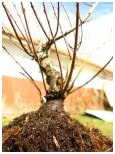
Picture of a Weeping willow Bonsai after pruning the first year before spring.
Image 2
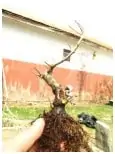
Picture of a Weeping Willow after pruning early spring the following year.
Image 3
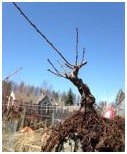
Picture of the Weeping willow Bonsai during fall the following year.
Image 4
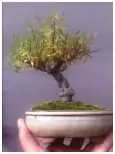
Picture of the Weeping Willow tree early spring the 4th year.
Does Weeping willow lose its leaves during winter?
Yes, just like most other deciduous plants, Weeping willow Bonsai lose their leaves during winter and autumn. However, Weeping willow is a fast-growing plant; therefore, it will grow back all lost leaves during spring.
Weeping willow Bonsai style
One of the beauties of weeping willow Bonsai is that they can be shaped into different styles. Discussed below are some of the beautiful ways you can style your Weeping willow Bonsai.
The Cascade style
This is the style that best suits the natural droopy pattern of a typical Weeping willow tree. This style boasts of upward growing trunks, bends, then points down to form a U shape turned upside down. If not properly trimmed, the leaves can outgrow the normal droopy length common to the cascade style. Leave the branches to grow horizontally, to encourage balance as well as give the Bonsai a much larger appearance.
The Semi-cascade style
The semi-cascade grows similarly with that of the Cascade style. It also gracefully displays their large and long leaves. They also grow in an upward direction but instead of pointing downwards like it is in the case of the Cascade style, it points sideways and stops once it levels up with the soil in the container.
The Formal upright style
Not everyone likes the saggy style which the Weeping willow is generally known for, and that is why this style was introduced as an alternative. As opposed to the downward growth of a weeping willow, this style favors upward growth.
This is quite an easy feat to achieve with a Weeping willow as it responds well to shaping due to the flexible nature of its branches: even though it is growing upwards, the leaves will downward slopping.
The Informal upright style
The informal style is one of the most styles widely used by most growers for a Weeping willow Bonsai. Weeping Willow trees are usually slightly bent, which makes it a natural match for the weathered and beaten appearance of the informal upright style.
A weeping willow styled in this manner will have similar look to that of a tree that has been greatly affected by weather, pests, and animals.
Dwarf Weeping willow Bonsai tree
Dwarf Weeping willow is one of the varieties of Salix cinerea (Gray willow) propagated by slender stem. It can be trained as a mounded shrub or a small tree. It has somewhat bent leaves, is slim, and is usually not longer than 2 to 4 inches. Its leaves are usually blue-green but turn gold during fall and barely have any leaves during late winter.
Japanese Weeping willow Bonsai
The Japanese Weeping willow is also known as Rokakudai Weeping Willow is a rare willow species. It boasts flexible strands, lush, green leaves, and slightly curvy branches as well as a big trunk.
Just like other members of the Weeping willow family and deciduous trees, the Japanese Weeping willow also drops its leaves during winter delighting growers and lovers of Bonsais to gracefully view its rounded and droopy branches.
How big do Weeping willow Bonsai trees get?
In the wild, a Weeping willow can grow up to 100 ft tall. But if they are grown indoors (as Bonsai) they can only be 3 to 6 feet tall; which makes them one of the best options for growers or gardeners with limited or small spaces.
How to make a Weeping willow Bonsai tree
For information on how to make a Weeping willow Bonsai with other Bonsai trees, refer to the section of this article where I discussed “How to wire a Weeping willow Bonsai tree” for details. But if you intend to know how to grow a Weeping willow from either cuttings, seed, or tree, check the next few sections for information.
How to bonsai Weeping willow from cuttings
It is much easier and faster to grow a Weeping willow Bonsai from cuttings than most other Bonsai trees. Discussed herein in the section are simplified steps that aimed to guide you through the processes involved.
- If you have normal-sized Weeping willow branches, remove all leaves and smaller branches and cut (the branches) into smaller sections.
- Place the several cuttings inside a bucket full of water or you can make use of a watering can and leave it soaked for a few weeks until you start to see signs of root formation.
- Withdraw the cuttings and put them in a portable nursery pot, making sure they always stay moistened until the cuttings bud is firmly established within the soil.
- In just a growing season, the cuttings may be ready to be repotted into a training pot. If ready, do not hesitate!
How to bonsai Weeping willow from seed
Growing a weeping willow from seed have a lot of added advantage, you get to study the tree as it progresses through the various stages and you also get to wire them into your desired style earlier on.
Read the following steps carefully to guide you through the process involved in growing a Weeping willow Bonsai with seeds.
- Get a big shallow pot that can contain up to 4 seeds.
- Put peat seed sowing mix inside the pot. (You can get the peat seed in a garden store)
- Put the Weeping willow seeds on top of the mix. Do not cover the pot as the seed needs a certain amount of sunlight to germinate.
- Get the soil moisturized with water.
- Take the pot outside so that the seed can receive direct sunlight.
- You must keep the soil moistened throughout this stage as water is an essential part of this stage. Your seed should germinate within a few weeks.
- Weeping willows are fast-growing trees, so you should repot each into an individual pot once you notice roots are starting to form (you should start initially with a Bonsai pot).
- Put a layer of the coarse substrate inside the pot.
- Plant the seedlings on the soil, then place another single layer of Bonsai soil on the seedlings to hold them firmly to the soil. You can use your fingers to press in the seedlings to compact them to the soil.
- Keep the soil moist by watering the young plant frequently. This should be done at least once a day and never let the soil dry out.
How to grow a Weeping willow Bonsai tree
It is very easy to grow a Weeping willow Bonsai tree. You can propagate the tree with either the seedlings or cuttings. All you have to do is leave the roots soaked in water for weeks until the sprouts become noticeable before planting inside the soil.
Why are my Weeping willow Bonsai leaves turning yellow?
If your Weeping willow richly green leaves are turning yellow it is most likely caused by stress due to lack of enough water. It can also be a result of a lack of mineral nutrients like; Iron and phosphorous.
How to save a dying Weeping willow Bonsai tree
According to Ron Smith, a horticulturist at the state university of North Dakota, Weeping willows don’t die suddenly but rather die gradually and mostly as a result of fungus infection and/or other extreme conditions. Stated below are useful tips on how you can save your dying Weeping willow tree.
- Get rid of dead branches, barks, and twigs using a knife or bandsaw, and make sure you apply to rub alcohol on the tools before you move from one area to another to disinfect them so that you don’t end up spreading the infection further. Remember to rake away removed dead debris afterward.
- Water the tree infrequently but enough to prevent the tree from suffering from water stress while in poor condition.
- Apply mulch made from wood barks on the tree base to keep the soil moisturizer as well as to prevent the growth of weed altogether. This is to help eliminate any possible competition for nutrients.
- Correct root rot by encouraging soil drainage.
- Apply enough fertilizer to the tree every year to ensure it never lacks any nutrient that is essential for healthy growth.
Is Weeping willow Bonsai safe for pets?
Are bonsai trees poisonous to cats? Some species, yes but Weeping willow is not safe for pets; especially cats. Although the Weeping willow leaves are considered safe for cats when they eat the bark or aspirin (a medicine made from weeping willow bark) it could be quite toxic. This is because most cats cannot digest the Salicylic acid found in the tree’s bark and aspirin.
Our recommendation: If you love bonsai trees that required full sunlight, please also have a look at coral bonsai tree, jack pine bonsai, liquidambar bonsai, cotoneaster horizontalis bonsai and bald cypress bonsai. These bonsai trees required min maintenance.
![Pittosporum Bonsai [Pittosporum Tobira]](https://www.bonsai-express.com/wp-content/uploads/2022/05/Pittosporum-Bonsai-365x200.jpg)
![Sorbus Bonsai [Sorbus Aucuparia]](https://www.bonsai-express.com/wp-content/uploads/2022/05/Sorbus-Bonsai-365x200.jpg)
![Tsuga Bonsai [Tsuga Canadensis]](https://www.bonsai-express.com/wp-content/uploads/2022/05/Tsuga-Bonsai-365x200.jpg)
![Tamarix Bonsai [Tamarix Ramosissima]](https://www.bonsai-express.com/wp-content/uploads/2022/05/Tamarix-Bonsai-365x200.jpg)